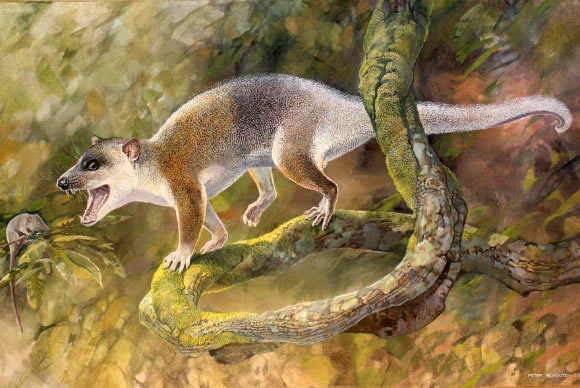Fossils discovered in Turkey represent a new species that is a previously unknown relative of modern-day marsupials, according to a new paper published in the journal PLoS ONE.
Named Anatoliadelphys maasae, the new species is an unusual, cat-sized carnivorous metatherian (marsupials and their relatives).
It lived in what is now Turkey during the middle Eocene epoch, about 43 million years ago.
With an estimated body mass of 3-4 kg, about the size of a domestic cat, the prehistoric animal is one of the largest metatherians known from the northern hemisphere, together with two North American species: the extant Virginia opossum (2.4 kg) and the extinct Didelphodon vorax (2-6 kg).
A three-dimensionally preserved skull and a near complete skeleton of Anatoliadelphys maasae were discovered and collected in 2002 from the Uzunçarşıdere Formation in central Turkey.
They were analyzed by Dr. Murat Maga from the University of Washington and Dr. Robin Beck from the Universities of Salford and New South Wales.
The analysis indicates that Anatoliadelphys maasae was agile and was able to climb and grasp, perhaps similarly to the modern-day spotted quoll.
Its strong jaws and large, broad premolars suggest that it was carnivorous and capable of crushing hard objects (durophagy), which would make it the first known Cenozoic carnivorous metatherian from the northern hemisphere.
“Anatoliadelphys maasae shows that northern hemisphere metatherians were far more diverse than we previously thought — they weren’t all small insect eaters,” Dr. Beck said.
“The northern hemisphere had numerous cat-sized carnivorous eutherians during the Cenozoic era, which may have competed with Anatoliadelphys maasae,” the paleontologists explained.
“However, carnivorous eutherians have yet to be found in the Uzunçarşıdere Formation, which was likely an island during this era.”
“This suggests that Anatoliadelphys maasae may have evolved in the absence of eutherian competitors, supporting the hypothesis that eutherians could outcompete metatherians where the two existed side-by-side.”
_____
A.M. Maga & R.M.D. Beck. 2017. Skeleton of an unusual, cat-sized marsupial relative (Metatheria: Marsupialiformes) from the middle Eocene (Lutetian: 44-43 million years ago) of Turkey. PLoS ONE 12 (8): e0181712; doi: 10.1371/journal.pone.0181712








